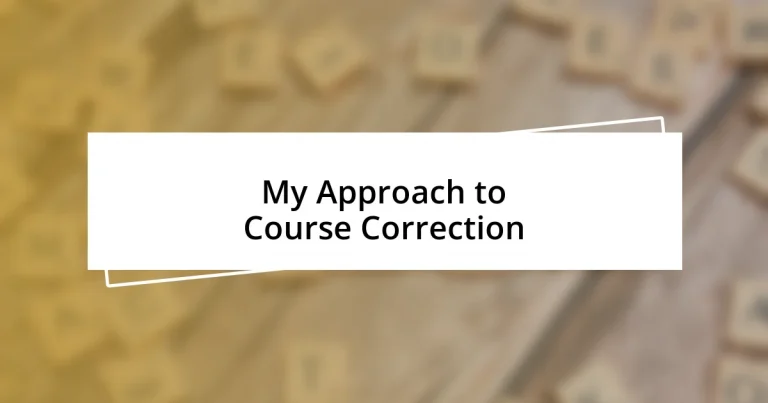Key takeaways:
- Flexibility and adaptability are crucial for effective course correction, allowing teams to pivot and innovate in response to challenges.
- Clear and transparent communication fosters team alignment, ownership, and creates opportunities for constructive feedback and growth.
- Continuous learning and reflection, including embracing failures as learning experiences, promote a culture of improvement and resilience within teams.
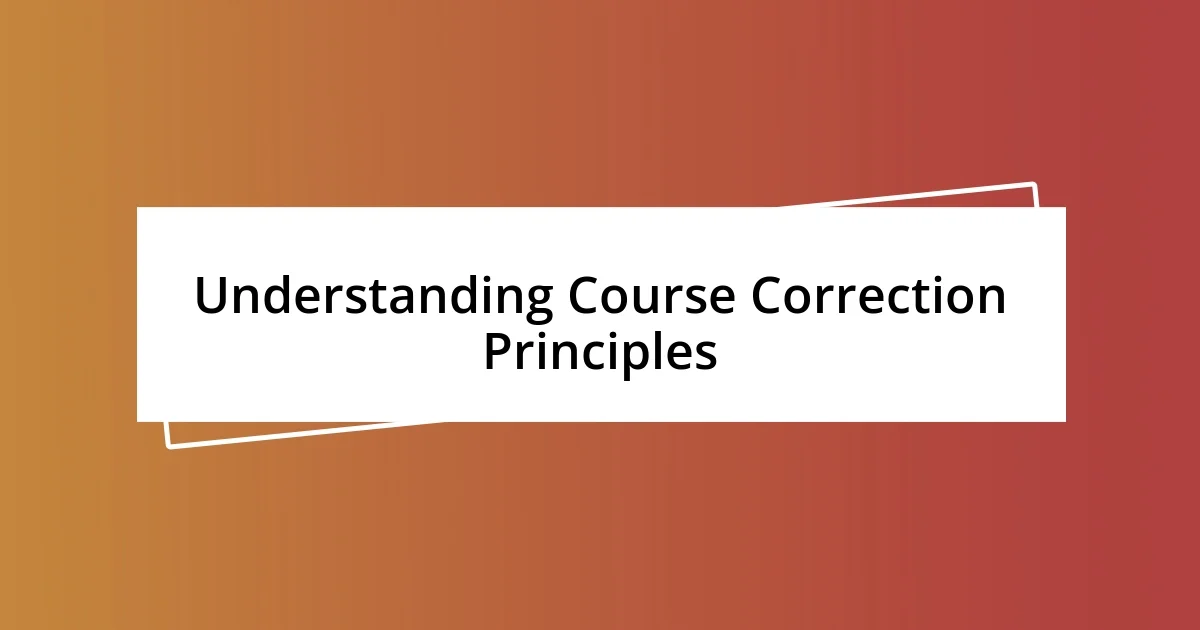
Understanding Course Correction Principles
Course correction is more than just making adjustments; it’s about understanding the underlying principles that guide these changes. I recall a time when a project I was passionate about went off track. Instead of panicking, I took a step back and asked, “What was the core issue here?” This reflective approach emphasized the importance of analyzing data and feedback before diving into solutions.
When navigating course correction, it’s vital to remain adaptable. I’ve learned that rigidity often leads to frustration, both for ourselves and our teams. Have you ever felt stuck in a plan that no longer served you? In my experience, embracing flexibility opens up pathways to innovative solutions, transforming setbacks into valuable learning experiences.
Finally, clear communication is a cornerstone of effective course correction. In one memorable project, I realized the team was misaligned because we hadn’t openly discussed our goals. This taught me that sharing visions and allowing room for input not only helps in identifying the need for adjustments but fosters a sense of collective ownership over the process. Isn’t it fascinating how a simple conversation can pivot an entire plan?
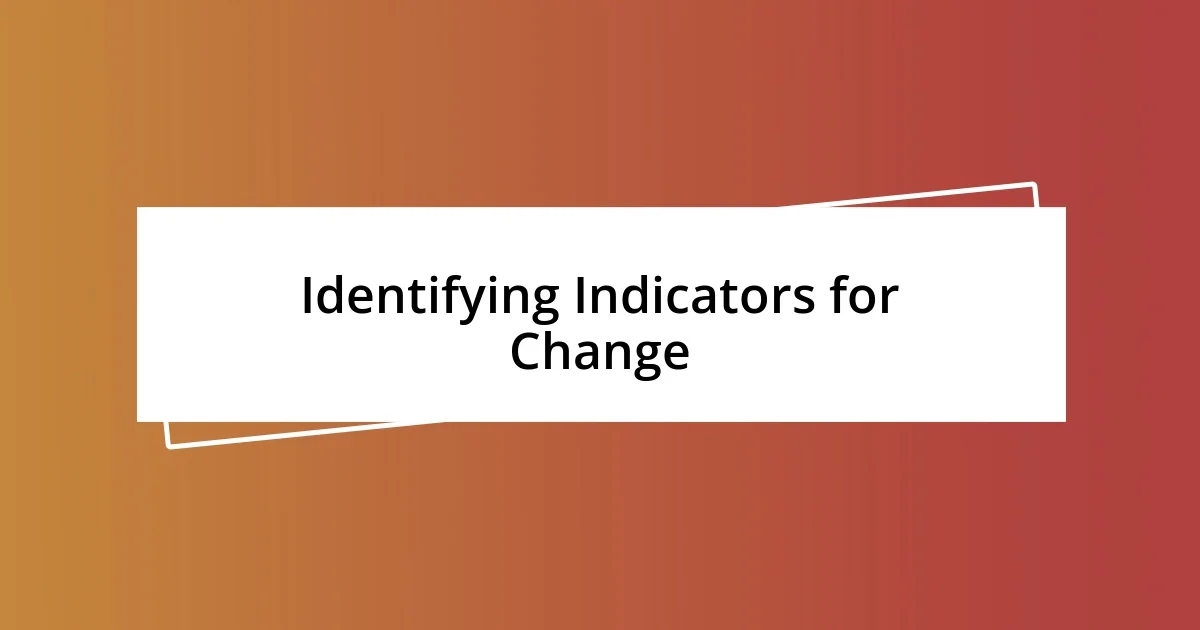
Identifying Indicators for Change
Identifying the right indicators for change is crucial in steering projects back on track. I remember a specific instance when project metrics started to show a significant decline, which raised alarm bells for me. Instead of dismissing these numbers, I chose to investigate their origins. This proactive approach revealed not just the symptoms of the problem but also the root causes that needed addressing. It’s essential to recognize these early warning signs before they snowball into more significant issues.
Another moment that stands out to me involved team dynamics. We had been experiencing some tension, which I initially attributed to external pressures. However, as I engaged in conversations with team members, it became clear that miscommunication was at play. This revelation transformed my approach to leadership—I started to seek feedback regularly, which became an indicator of our team’s overall health. Engaging emotionally with my team allowed me to sense these shifts more quickly, enabling timely intervention.
To make informed decisions, I’ve found it valuable to maintain a balance of qualitative and quantitative indicators. For example, while metrics can show performance drops, qualitative feedback can reveal unspoken issues. One time, during a project review, I noticed the numbers were down, but the team expressed a renewed enthusiasm in their discussions. This taught me that sometimes, a positive outlook amidst challenges can signal a shift worth exploring further.
| Indicator Type | Description |
|---|---|
| Quantitative | Data-driven metrics like KPIs (Key Performance Indicators) that highlight trends or performance shifts. |
| Qualitative | Feedback from team discussions, surveys, or one-on-one conversations revealing emotional or contextual issues. |

Analyzing Current Performance Trends
When analyzing current performance trends, I often reflect on how easily data can become overwhelming. I remember an instance where I led a project and drowned in a sea of numbers. It felt daunting, yet by stepping back, I realized that just a few key metrics could tell the entire story. This experience taught me that it’s beneficial to focus on crucial indicators rather than getting lost in every detail. Striking this balance allows for quick, effective decision-making.
Here are some essential points to consider:
- Identify Core Metrics: Focus on a handful of performance indicators that truly reflect your goals.
- Contextualize Data: Understand the story behind the numbers to capture emotional and situational nuances.
- Engage Your Team: Include team input in performance evaluations to foster a sense of shared responsibility.
- Stay Adaptable: Be prepared to pivot your focus as trends evolve and new challenges arise.
Engaging with performance trends isn’t just about the figures; it’s about the stories they tell us. In my own experience, when I dug deeper into our performance issues, I found that team morale significantly impacted our output. Recognizing emotions within the metrics—like a dip in enthusiasm paired with a drop in productivity—has been enlightening. This dual insight not only informs course corrections but also strengthens team cohesion, reminding us that every number has a pulse.

Developing a Course Correction Strategy
Creating a solid course correction strategy starts with a clear understanding of not just what went wrong, but why it went wrong. I remember a project where we faced unexpected delays. Initially, I felt frustrated, but upon reflection, I realized we hadn’t accounted for dependencies between tasks. This experience taught me that a strategy should begin with mapping out the connections in the workflow. How can we expect to adjust our path without truly seeing the landscape ahead?
Once I identified the underlying issues, I turned to the team for their input. It was eye-opening to discover that many of them had insights I hadn’t considered. One team member suggested we implement regular check-in meetings to discuss progress and challenges openly. Listening to their feedback made me realize that a collaborative approach not only enriches the strategy but also fosters a sense of ownership among team members. I believe in the power of collective wisdom—I often ask myself, aren’t we all in this together?
In developing a course correction strategy, I’ve also found it vital to keep an adaptable mindset. For instance, during one initiative, we had to pivot drastically due to unforeseen market changes. Initially, it felt disconcerting, but embracing flexibility in our plans allowed us to innovate in ways I hadn’t anticipated. This taught me that being responsive and open-minded can ignite creativity and drive us toward solutions we might never have explored if we clung too tightly to our original path. How have shifting circumstances influenced your own strategies?

Implementing Effective Adjustment Tactics
When implementing effective adjustment tactics, I often find that the key lies in prioritizing transparency. In one instance, during a product rollout that wasn’t generating the expected interest, I rallied the team for a candid discussion. I was nervous, but the open dialogue revealed underlying assumptions we had overlooked. This experience reinforced my belief that honest communication is crucial; it not only clarifies the path forward but also builds trust within the team.
Another tactic I swear by is the concept of iterative feedback. I remember redesigning a marketing campaign after it fell flat. By introducing a sequence of small tweaks rather than a complete overhaul, I could gauge the audience’s reactions in real time. Each bit of feedback felt like an opportunity rather than a setback. Isn’t it fascinating how slight changes can lead to significant outcomes? This approach encourages a culture where mistakes are not feared but embraced as a way of growing toward success.
Lastly, fostering a reflective mindset can significantly impact how we adjust our tactics. After a failed project, I took some time to journal my experiences. It was my way of processing the lessons learned. This reflective practice helped me identify patterns in my decision-making that needed adjusting. Have you ever taken a moment to step back and reflect? I find that these pauses can illuminate the most productive paths forward, allowing me to approach challenges with renewed clarity and purpose.
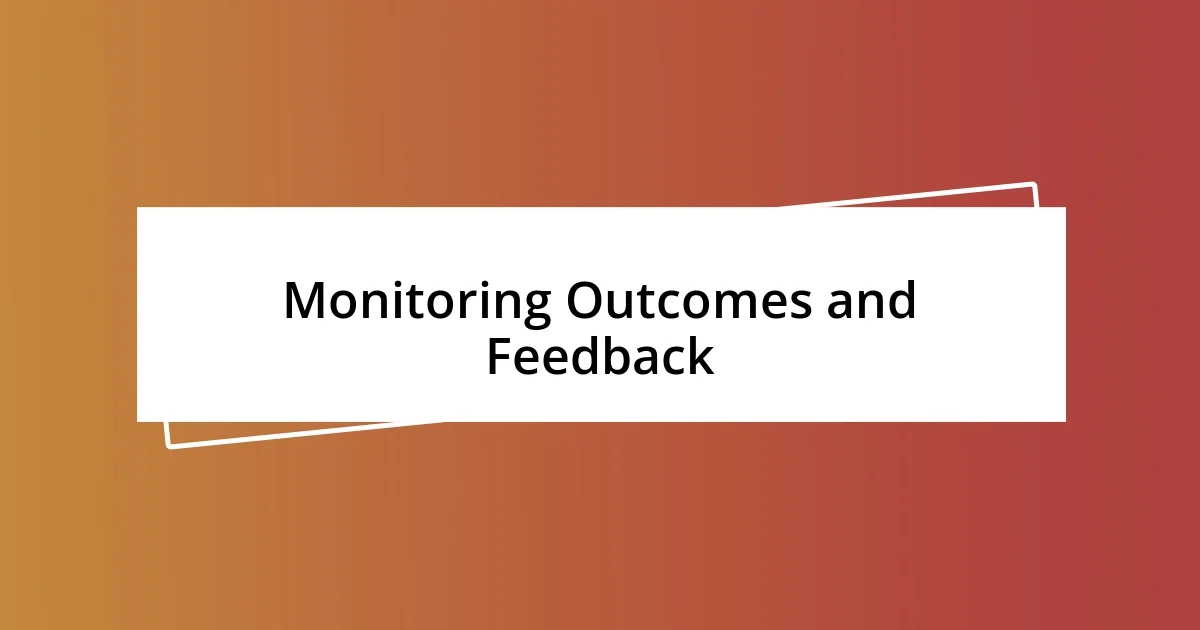
Monitoring Outcomes and Feedback
Monitoring outcomes and feedback is absolutely essential in every project I tackle. For instance, during a quarterly review of a key initiative, I implemented a system where we tracked various performance metrics weekly. I found that having real-time data not only kept everyone informed but also highlighted successes and areas needing improvement almost immediately. Isn’t it incredible how numbers can tell a story we might not see otherwise?
Reflecting on past challenges, I once realized the importance of gathering qualitative feedback after a product launch. We organized a small focus group to discuss users’ experiences directly. Listening to their reactions—the excitement, the confusion, and even the frustrations—was incredibly valuable. It felt like a light bulb moment. Have you ever considered how direct customer insights could reshape your approach? I certainly learned that this hands-on feedback often reveals nuances that data alone cannot capture.
Additionally, I’ve come to appreciate the rhythm of regular feedback loops. In one project, I encouraged team members to provide input not only on outcomes but also on the processes we were using. This led to honest discussions about what was working and what wasn’t. I felt a sense of camaraderie building as we collectively recognized our shared triumphs and challenges. Wouldn’t you agree that fostering this open dialogue creates a more engaged and innovative team?
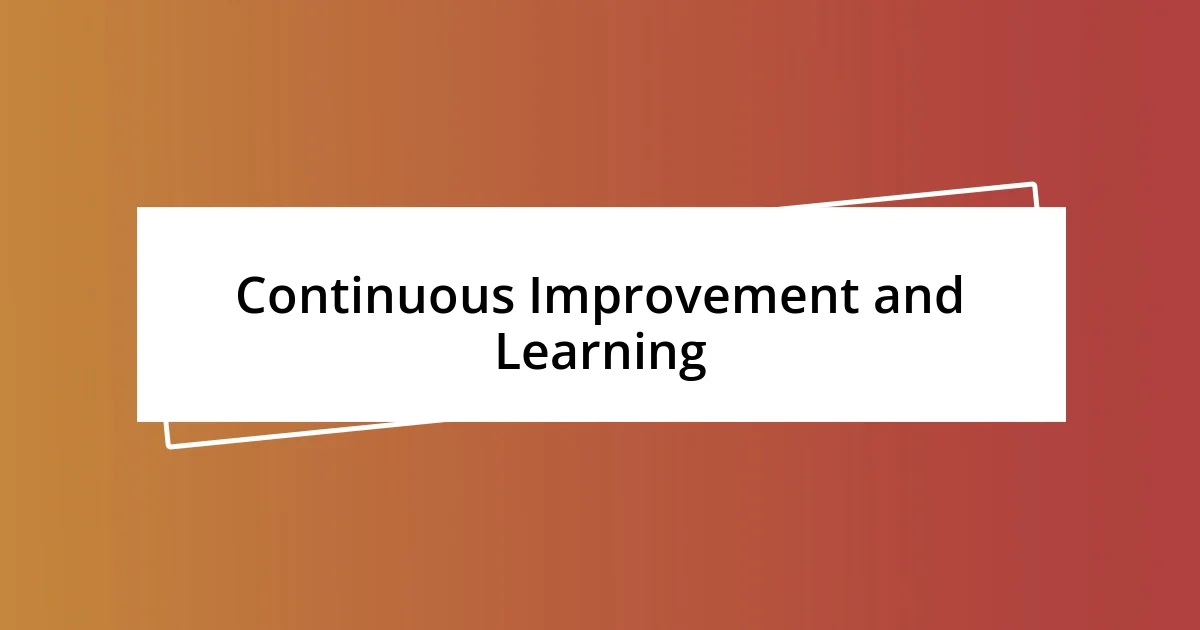
Continuous Improvement and Learning
I believe that continuous improvement and learning should be woven into the fabric of our daily routines. For example, during a recent team workshop, I encouraged everyone to share one lesson learned from a failed project. The discussions ranged from missed deadlines to misjudged audience interests, and I felt a tangible shift in our energy. It was liberating to acknowledge our mistakes together. Don’t you think that embracing vulnerability fosters growth in ways we often overlook?
Moreover, I’ve found that creating space for learning can make a significant difference. In my experience, I once introduced ‘failure Fridays,’ where we spent an hour discussing our weekly setbacks. Initially, I was unsure how the team would react, but to my surprise, everyone left feeling lighter. It became clear that transforming failures into learning opportunities can fundamentally change how we approach challenges. Have you ever tried turning embarrassment into empowerment?
Ultimately, I cherish the idea of ongoing education as both a professional and personal journey. I recall taking an online course on emerging marketing trends, not just to stay relevant but to reignite my passion for the field. The excitement of learning something new invigorated my approach to existing projects. It reminded me that every moment offers the potential for insight, urging us all to remain curious. Isn’t that the essence of what makes our work consistently rewarding?











